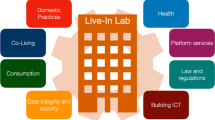Abstract
Although there is a history in urban thought wherein scholars view cities as technologies, the encompassing character of such views inherently limits them. In turn, their usefulness does not efficiently support the kind of thinking that is required to deliver worthwhile outcomes that can promote social justice and human flourishing. However, narrowing the focus through examining municipalities as technologies offers possibilities that can help us achieve such goals. To maximize the utility of this endeavor, employing the structural-ethics approach provides a way to assess urban technologies to achieve success. In this paper, the author explores the ideas above, revealing how they advance our thinking when it comes to remaking, planning, and building existing and future cities. The article concludes by linking these claims to other lessons in urban studies and geography.
Similar content being viewed by others
Notes
For an example of urban ontology, see Weissman (2011). Cities, Real and Ideal: Categories for an Urban Ontology. Heusentamm, Germany: Ontos Verlag. For a discussion on the city as a process, see Varzi (2019). What is a city? Topoi: An International Review of Philosophy (online available; print version is forthcoming).
It is worth noting that ontology does play a role when it comes to the related ethical concerns of the city and the municipality. For instance, when comparing the complexity of “the city” to the reduced complexity of “the municipality,” it seems reasonable to hold that less complexity would make it easier to identify ethically problematic situations.
There are also many philosophers who argue for a value-neutral position. See Peterson and Spahn (2011). “Can technological artifacts be moral agents?”. Science and Engineering Ethics, 17(3), 411–424. And, Pitt 2014. “Guns do not kill people; values in and/or around technologies.” In P. Kroes & P.P. Verbeek (Eds.), The moral status of technical artifacts (pp. 89–102). Dordrecht, Netherlands: Springer.
I can imagine someone claiming: “you are committing the strawperson fallacy because you are not directly making an argument against technological agency.” Yet, this criticism misses the point: I have no interest in making technological-agency arguments. There is no need to do so because the inherent nature of the structural ethics approach bypasses the need to discuss agency.
For intellectual and philosophical purposes, an exploration wherein agency remained in view could benefit this discussion, an exercise that falls outside of the scope of this paper.
I review these points in different contexts elsewhere. For more information, see Epting, S. Danger in the Rocks? Thinking through Land Use and Naturally-Occurring Asbestos with Structural Ethics, Ethics and the Environment (forthcoming).
For a thorough presentation of this kind of research, see Bettencourt et al. (2007). Growth, Innovation, Scaling, and the Pace of Life in Cities. Proceeding of the National Academy of Science 104 (17), 7301–7306.
References
Bettencourt, L., & West, G. (2010). A unified theory of urban living. Nature, 467, 912–913.
Bettencourt, L., Lobo, J., Helbing, D., Kühnert, C., & West, G. (2007). Growth, innovation, scaling, and the pace of life in cities. Proceedings of the National Academy of Sciences, 104(17), 7301–7306.
Brey, P. (2014). From moral agents to moral factors: The structural ethics approach. In the moral status of technical artefacts (pp. 125–142). Dordrecht: Springer.
Campbell, C., Greenberg, R., Mankikar, D., & Ross, R. (2016). A case study of environmental injustice: The failure in Flint. International Journal of Environmental Research and Public Health, 13(10), 951.
Edward, G. (2011). Triumph of the city: How our greatest invention makes us richer, smarter, greener, healthier, and happier. New York: Penguin.
Epting, S. (2017). On moral prioritization in environmental ethics: weak anthropocentrism for the city. Environmental Ethics, 39(2), 131–146.
Genosko, G. (2015). Megamachines: From Mumford to Guattari. Explorations in Media Ecology, 14(1–2), 7–20.
Guattari, F. (2015). Machinic Eros: Writings on Japan, ed. Gary Genosko and Jay Hetrick. Minneapolis: Univocal Publishing.
Harvey, D. (2008). The right to the city. New Left Review, 53(September–October), 23–40.
Jonas, H. (1984). The imperative of responsibility: In search of an ethics for the technological age. Chicago: University of Chicago Press.
Latour, B. (1994). Where are the missing masses? The sociology of a few mundane artifacts. In W. E. Bijker & J. Law (Eds.), Shaping technology/building society: Studies in sociotechnical change (pp. 225–258). Cambridge: MIT Press.
Lefebvre, H. (2000). In Writings on cities (Kofman E, & Lebas E, Eds., Trans.). Oxford: Blackwell.
Maantay, J. (2002). Zoning law, health, and environmental justice: what's the connection? The Journal of Law, Medicine & Ethics, 30(4), 572–593.
Mumford, L. (1937). What is a city? Architectural Record, 82(5), 59–62.
Pasha, O. (2018). Social justice implications of municipal transportation apportionments in Massachusetts: A case of disparate impact. Transport Policy, 72, 109–115.
Peterson, M., & Spahn, A. (2011). Can technological artefacts be moral agents? Science and Engineering Ethics, 17(3), 411–424.
Pitt, J. (2014). Guns don’t kill people; values in and/or around technologies. In P. Kroes & P. P. Verbeek (Eds.), The moral status of technical artefacts (pp. 89–102). Dordrecht: Springer.
Smith, M. (2019). Flint water prosecutors drop criminal charges, with plans to keep investigating. New York Times, June 13. Available online, https://www.nytimes.com/2019/06/13/us/flint-water-crisis-charges-dropped.html. Accessed 14 Feb 2020.
Swyngedouw, E. (2006). Metabolic urbanization: The making of cyborg cities. In In the nature ofcities (–36, 55). Routledge.
Varzi, A. (2019). What is a city? Topoi: An International Review of Philosophy (forthcoming).
Verbeek, P.-P. (2011). Moralizing technology: Understanding and designing the morality of things. Chicago: University of Chicago Press.
Weissman, D. (2011). Cities, real and ideal: Categories for an urban ontology. Heusentamm: Ontos Verlag.
Author information
Authors and Affiliations
Corresponding author
Additional information
Publisher’s Note
Springer Nature remains neutral with regard to jurisdictional claims in published maps and institutional affiliations.
Rights and permissions
About this article
Cite this article
Epting, S. On Municipalities as Technologies. Philos. Technol. 34, 863–873 (2021). https://doi.org/10.1007/s13347-020-00438-z
Received:
Accepted:
Published:
Issue Date:
DOI: https://doi.org/10.1007/s13347-020-00438-z




